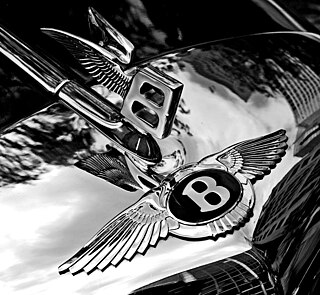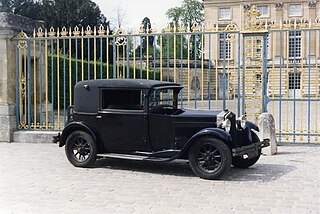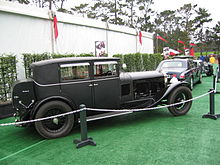
Bentley Motors Limited is a British designer, manufacturer and marketer of luxury cars and SUVs. Headquartered in Crewe, England, the company was founded as Bentley Motors Limited by W. O. Bentley (1888–1971) in 1919 in Cricklewood, North London, and became widely known for winning the 24 Hours of Le Mans in 1924, 1927, 1928, 1929 and 1930. Bentley has been a subsidiary of the Volkswagen Group since 1998 and consolidated under VW's premium brand arm Audi since 2022.

The Gare de Lyon, officially Paris-Gare-de-Lyon, is one of the six large mainline railway stations in Paris, France. It handles about 148.1 million passengers annually according to the estimates of the SNCF in 2018, with SNCF railways and RER D accounting for around 110 million and 38 million on the RER A, making it the second-busiest station of France after the Gare du Nord and one of the busiest in Europe.

Walter Owen Bentley, was an English engineer who founded Bentley Motors Limited in London. He was a motorcycle and car racer as a young man. After making a name for himself as a designer of aircraft and automobile engines, Bentley established his own firm in 1919. He built the firm into one of the world's premier luxury and performance auto manufacturers, and led the marque to multiple victories at the 24 Hours of Le Mans. After selling his namesake company to Rolls-Royce Limited in 1931, he was employed as a designer for Lagonda, Aston Martin, and Armstrong Siddeley.

Sir Henry Ralph Stanley Birkin, 3rd Baronet, known as Tim Birkin, was a British racing driver, one of the "Bentley Boys" of the 1920s.

The Rolls-Royce Corniche is a two-door, front-engine, rear wheel drive luxury car produced by Rolls-Royce Motors as a hardtop coupé and as a convertible.

The Bentley 6½ Litre and the high-performance Bentley Speed Six were rolling chassis in production from 1926 to 1930. The Speed Six, introduced in 1928, would become the most successful racing Bentley. Two Bentley Speed Sixes became known as the Blue Train Bentleys after their owner Woolf Barnato's involvement in the Blue Train Races of 1930.

The Bentley 3½ Litre was presented to the public in September 1933, shortly after the death of Henry Royce, and was the first new Bentley model following Rolls-Royce's acquisition of the Bentley brand in 1931.

The Bentley Boys were a group of wealthy British motorists who drove Bentley sports cars to victory in the 1920s and kept the marque's reputation for high performance alive. In 1925, as the marque foundered, Bentley Boy Woolf Barnato bought the company, leading to the creation of the famous supercharged Bentley Blower car.

Joel Woolf Barnato was a British financier and racing driver, one of the "Bentley Boys" of the 1920s. He achieved three consecutive wins out of three entries in the 24 Hours of Le Mans race.

Lille-Europe station is a SNCF railway station in Lille, France, on the LGV Nord high-speed railway. The station is primarily used for international Eurostar and long-distance SNCF TGV services, although some high-speed regional trains also call at the station. The station was built in 1993 to be used as a through station for trains between the UK, Belgium, and the Netherlands, as well as French TGV services, except those coming from Paris which normally terminate at Lille-Flandres. There is a 400 m (1,300 ft) walking distance between the two stations, which are also adjacent stops on the Lille Metro.
The 1930 24 Hours of Le Mans was the 8th Grand Prix of Endurance that took place at the Circuit de la Sarthe on 21 and 22 June 1930. It saw the first appearance of a German car and the first entry from female drivers.
The Calais-Mediterranée Express was a French luxury night express train which operated from 1886 to 2003. It gained international fame as the preferred train of wealthy and famous passengers between Calais and the French Riviera during the interwar period. It was colloquially referred to as Le Train Bleu in French and the Blue Train in English because of its dark-blue sleeping cars.
In Top Gear, a BBC motoring show, one of the show's regular features since 2002 is various forms of racing the presenters undertake, either against each other or against invited guests. The show has featured a number of epic races, where one of the presenters — Jeremy Clarkson, Richard Hammond, James May, and occasionally The Stig — drives a car in a race against the others in another form of transport. These races typically involve Clarkson driving the car while Hammond and May take the same journey by combinations of plane, train, or ferry. May has said that the races are planned to be as close as possible. Of the long-distance races so far, the car has won the vast majority of the races, with the exceptions of the cross-London epic, in which the car was beaten by a bicycle, a boat on the Thames and public transport; Ferrari Daytona vs. Powerboat, in which the boat won; Shelby Mustang GT500 vs. High Speed Train, in which the train won; and the Arabian Peninsula race, in which the alternative 'money no-object' transportation options beat the Bugatti Chiron.

The Rover Light Six was a narrower lightweight short wheelbase variant of their Two-litre sports saloon produced from 1929 to 1930 by the Rover Company of Coventry. The following season it was sold with a 2½-litre 20 hp engine under the name Rover Light Twenty.
Dudley Noble, who started at the Rover Company in 1911 as a motorcycle tester and competition rider, became one of the British automobile industry's pioneering publicists.

The Bentley Mulsanne is a full-size luxury car that was manufactured by Bentley from 2010 to 2020. The car is named after the Mulsanne Straight of the Le Mans racing circuit, where Bentley have raced many of its cars throughout history. Designed to replace the Rolls-Royce based Arnage, the Mulsanne was the first flagship car to be independently designed by Bentley Motors since W.O. Bentley's 8 litre model in 1930.

Weymann Fabric Bodies is a patented design system for fuselages for aircraft and superlight coachwork for motor vehicles. The system used a patent-jointed wood frame covered in fabric. It was popular on cars from the 1920s until the early 1930s as it reduced the usual squeaks and rattles of coachbuilt bodies by its use of flexible joints between body timbers.

Bentley Blower No.1 is a racing car developed from the Bentley 4½ Litre by Sir Henry "Tim" Birkin to win the Le Mans twenty-four-hour race. The car was developed into its current form for racing at Brooklands.
The Rover Two-litre was a mid-size luxury open tourer, saloon or limousine produced from 1927 by the Rover Company of Coventry and available through to 1932. As usual the chassis was also available to coach builders.
















